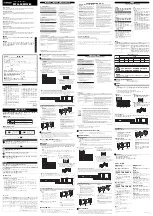
ENGINEERING MANUAL OF AUTOMATIC CONTROL
DAMPER SELECTION AND SIZING
447
INTRODUCTION
This section familiarizes the reader with dampers, including
types, construction, performance, environment capability,
actuators, and linkages, and describes criteria used for proper
selection and sizing of dampers. Dampers are typically chosen
based on duct size and convenience of location. Rather than using
duct size, criteria and methods are provided to select and properly
size dampers which will produce desired control results. This can
eliminate the undesirable effects of oversized dampers.
The information provided is general for all dampers. Selection
and sizing of specific dampers can only be accomplished through
the use of specific manufacturer’s documentation.
Dampers in HVAC systems regulate the flow of air either by
modulating or two-position control. They are normally connected
to actuators by linkages and operate in response to a pneumatic,
electric, or electronic control signal. In theory, the application of
dampers in HVAC systems closely parallels that of control valves.
DEFINITIONS
Actuator: A device used to operate a damper or control valve
in a control system.
Baffle: An orifice placed in the duct to reduce the duct size to
the damper size.
Damper seals: Construction features used to minimize the
leakage through a damper.
Damper system: The damper plus the series resistance that relates
to it (e.g., duct work, mixing boxes, diffusers, and coils).
Damper: A device used to regulate the flow of air in an HVAC
system by modulating or two-position control.
Drive blade: A damper blade that is driven directly by an
actuator or by a linkage, axle, or jackshaft connected
to the drive blade in an adjacent damper section.
Fire damper: A thermally actuated damper arranged to
automatically restrict the passage of fire and/or heat
at a point where an opening violates the integrity of a
fire partition or floor.
Ideal damper system: A system with a linear relationship
between the percent open damper position and the
percent of full airflow.
Leakage: The amount of air passing through a damper with a
given pressure drop and a given torque holding the
damper closed.
Opposed blade damper: A damper constructed so adjacent
blades rotate opposite to each other.
Parallel blade damper: A damper constructed so each blade
rotates in the same direction as the blade next to it.
Smoke damper: A damper arranged to control passage of
smoke through an opening or a duct.
Summary of Contents for AUTOMATIC CONTROL SI Edition
Page 1: ...AUTOMATIC CONTROL for ENGINEERING MANUAL of COMMERCIAL BUILDINGS SI Edition ...
Page 4: ...ENGINEERING MANUAL OF AUTOMATIC CONTROL iv ...
Page 6: ...ENGINEERING MANUAL OF AUTOMATIC CONTROL vi ...
Page 46: ...ENGINEERING MANUAL OF AUTOMATIC CONTROL CONTROL FUNDAMENTALS 36 ...
Page 66: ...ENGINEERING MANUAL OF AUTOMATIC CONTROL PSYCHROMETRIC CHART FUNDAMENTALS 56 ...
Page 128: ...ENGINEERING MANUAL OF AUTOMATIC CONTROL ELECTRIC CONTROL FUNDAMENTALS 118 ...
Page 158: ...MICROPROCESSOR BASED DDC FUNDAMENTALS 148 ENGINEERING MANUAL OF AUTOMATIC CONTROL ...
Page 208: ...ENGINEERING MANUAL OF AUTOMATIC CONTROL BUILDING MANAGEMENT SYSTEM FUNDAMENTALS 198 ...
Page 493: ...INDEX ENGINEERING MANUAL OF AUTOMATIC CONTROL 483 INDEX ...
Page 506: ...ENGINEERING MANUAL OF AUTOMATIC CONTROL INDEX 496 NOTES ...
Page 507: ...INDEX ENGINEERING MANUAL OF AUTOMATIC CONTROL 497 NOTES ...
Page 508: ...ENGINEERING MANUAL OF AUTOMATIC CONTROL INDEX 498 NOTES ...
Page 509: ...INDEX ENGINEERING MANUAL OF AUTOMATIC CONTROL 499 NOTES ...
Page 510: ...ENGINEERING MANUAL OF AUTOMATIC CONTROL INDEX 500 NOTES ...
Page 511: ...INDEX ENGINEERING MANUAL OF AUTOMATIC CONTROL 501 NOTES ...
Page 512: ...ENGINEERING MANUAL OF AUTOMATIC CONTROL INDEX 502 NOTES ...
















































